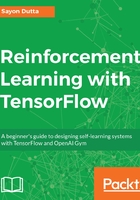
The gradient descent algorithm
The gradient descent algorithm is an optimization algorithm to find the minimum of the function using first order derivatives, that is, we differentiate functions with respect to their parameters to first order only. Here, the objective of the gradient descent algorithm would be to minimize the cost function  with regards to
with regards to and
and .
.
This approach includes following steps for numerous iterations to minimize  :
:
 used in the above equations refers to the learning rate. The learning rate is the speed at which the learning agent adapts to new knowledge. Thus,
used in the above equations refers to the learning rate. The learning rate is the speed at which the learning agent adapts to new knowledge. Thus,  , that is, the learning rate is a hyperparameter that needs to be assigned as a scalar value or as a function of time. In this way, in every iteration, the values of
, that is, the learning rate is a hyperparameter that needs to be assigned as a scalar value or as a function of time. In this way, in every iteration, the values of  and
and are updated as mentioned in the preceding formula until the value of the cost function reaches an acceptable minimum value.
are updated as mentioned in the preceding formula until the value of the cost function reaches an acceptable minimum value.
The gradient descent algorithm means moving down the slope. The slope of the the curve is represented by the cost function  with regards to the parameters. The gradient, that is, the slope, gives the direction of increasing slope if it's positive, and decreasing if it's negative. Thus, we use a negative sign to multiply with our slope since we have to go opposite to the direction of the increasing slope and toward the direction of the decreasing.
with regards to the parameters. The gradient, that is, the slope, gives the direction of increasing slope if it's positive, and decreasing if it's negative. Thus, we use a negative sign to multiply with our slope since we have to go opposite to the direction of the increasing slope and toward the direction of the decreasing.
Using the optimum learning rate,  , the descent is controlled and we don't overshoot the local minimum. If the learning rate,
, the descent is controlled and we don't overshoot the local minimum. If the learning rate,  , is very small, then convergence will take more time, while if it's very high then it might overshoot and miss the minimum and diverge owing to the large number of iterations:
, is very small, then convergence will take more time, while if it's very high then it might overshoot and miss the minimum and diverge owing to the large number of iterations:


